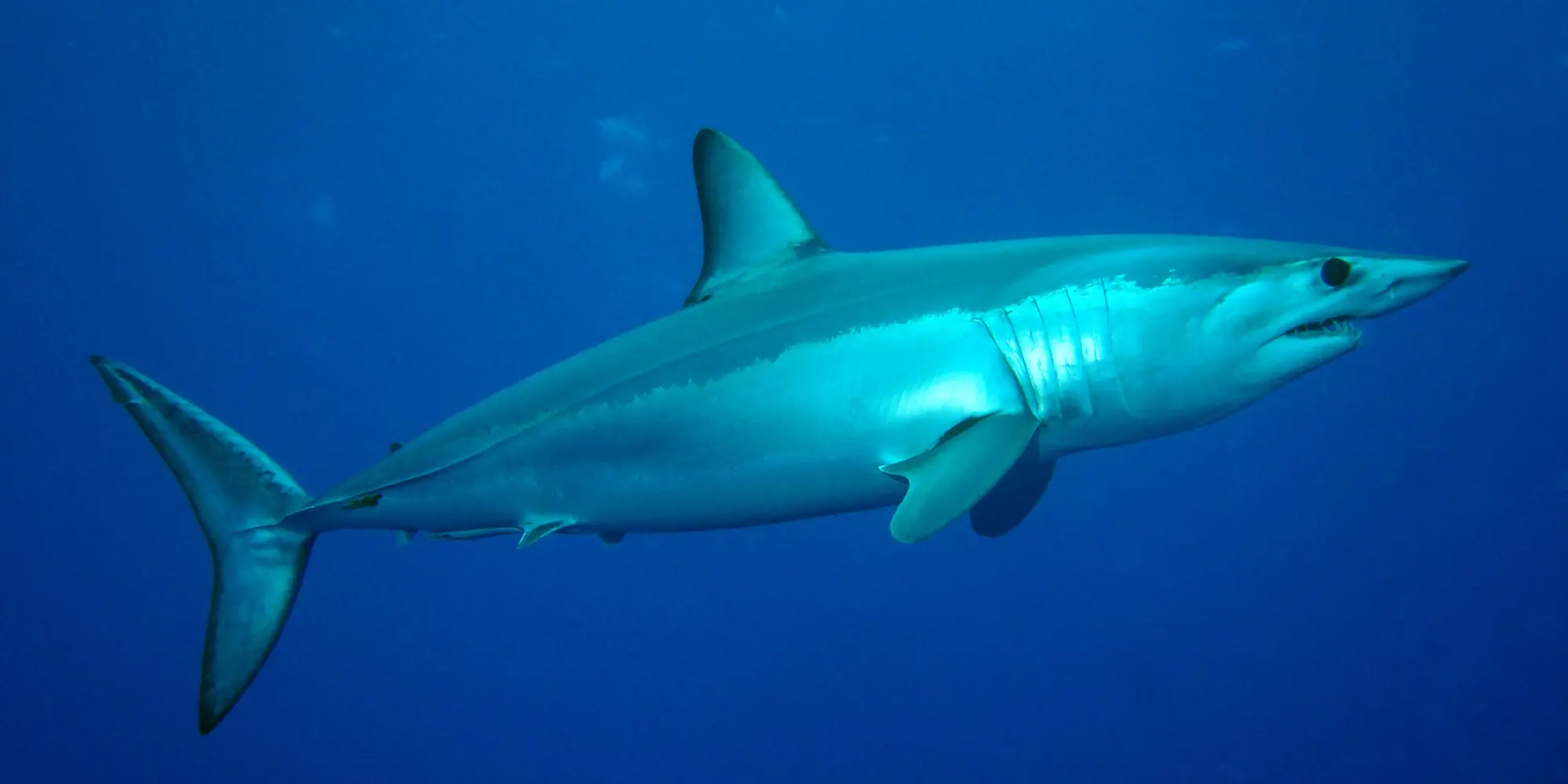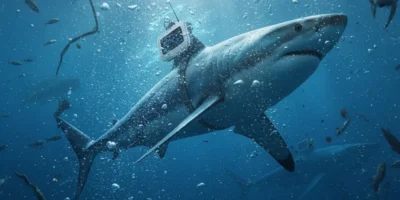Body Structure, Characteristics & Anatomy
The shortfin mako, scientifically known as Isurus oxyrinchus, is one of the most impressive open-ocean sharks. Its anatomy is perfectly adapted for speed, hunting success, and life in the open sea. With its streamlined body, it is considered the fastest shark in the world, reaching impressive speeds of over 70 km/h.
Body shape and basic structure
The silhouette of the shortfin mako is spindle-shaped and highly hydrodynamic. The body tapers towards the rear, allowing for minimal water resistance. Compared to other sharks, its body appears more compact, which, along with the shape of the fins, optimizes propulsion.

Head and jaws
The head is characterized by a pointed snout that favors water flow while swimming. The lower jaw is powerful and contains a row of sharp, sickle-shaped teeth. These teeth grow in multiple rows and are ideal for firmly grasping prey such as tuna or mackerel. Unlike many other shark species, the shortfin mako hunts actively, relying on lightning-fast attacks.
Fins and locomotor system
A characteristic feature is the relatively short, triangular pectoral fin, which provides stability at high speeds. The dorsal fin is comparatively small, while the strong, crescent-shaped tail fin generates tremendous propulsion. Within the musculature, the mako has a special thermoregulation system that allows it to maintain its body temperature slightly above the surrounding seawater, enabling particularly powerful swimming.
Skin and coloration
The skin is covered with tiny placoid scales, called dermal denticles. These act like microscopic rough-surfaced scales that reduce water resistance and further enhance speed. The coloration shows a deep blue or steel-gray on the upper side, while the underside is white. This contrast pattern serves as camouflage: from above, the shark blends with the darkness of the ocean, and from below, with the lighter water surface.
Differences between males and females
As with many shark species, the shortfin mako also exhibits sexual dimorphism, which is recognizable both externally and anatomically.
Males
Male shortfin makos are generally smaller than females, reaching average lengths of about 2 to 2.5 meters. A distinctive feature is the so-called claspers – paired extensions on the pelvic fins that play a role in reproduction. Males also grow more slowly and reach sexual maturity earlier.
Females
Female makos can grow significantly larger, reaching lengths of over 3.5 meters. They have more robust bodies, which is particularly advantageous for carrying their live-born young. Females reach reproductive maturity later, which is related to their longer growth cycle. Their larger size also gives them advantages when hunting bigger prey.
Special adaptations
The combination of powerful musculature, specialized fins, and a hydrodynamic body shape makes the shortfin mako an excellent predator. Its physiological adaptations allow it to pursue prey even into deeper water layers and quickly return to the surface. Thanks to its temperature regulation system, it remains particularly energetic during these hunts.
Distribution & Habitat
The shortfin mako, also known as the mako shark, inhabits a vast range across the world’s oceans. This species is found in nearly all tropical and subtropical waters, making it one of the most widely distributed shark species worldwide. Makos prefer regions with warm water temperatures of around 16 degrees Celsius and avoid colder zones.
Worldwide distribution
The distribution range of the shortfin mako extends across all oceans:
- Atlantic Ocean: In the west, from the Gulf of Maine to southern Brazil, including the Gulf of Mexico, the Bahamas, and the Caribbean. In the east, their habitats extend from Norway and the British Isles down to South Africa.
- Indian Ocean: The mako is found throughout the Indian Ocean, including the Red Sea.
- Mediterranean Sea: This shark species is also found in the Mediterranean Sea, although its population there has declined sharply in recent decades.
- Pacific Ocean: In the western Pacific, the mako inhabits the coasts of Indonesia, Korea, Japan, Australia, Tasmania, New Zealand, and New Caledonia. In the east, its range extends from the southern Aleutian Islands to Chile.
The shortfin mako also regularly inhabits the open sea. It is a strong migrator, covering enormous distances during its journeys to reach feeding grounds or suitable breeding areas. Both juvenile and adult individuals are found in temperate to tropical waters between 50° North and 50° South.

Typical Habitats
The habitat of the shortfin mako is extremely varied. It is most often found in coastal waters and along the edge of the continental shelf, but it also ventures into the open sea. It is frequently encountered from the surface down to about 150 meters, although some individuals can dive considerably deeper.
Makos prefer open, plankton-rich regions where numerous prey fish such as tuna, mackerel, and swordfish live. Proximity to the coast favors hunting, but even on the open sea these sharks are highly adaptable. Water temperature plays a major role: the mako feels most comfortable in waters between 16 and 22 degrees Celsius. Extreme temperatures or lack of oxygen cause it to avoid certain areas.
Special features of habitat selection
Makos are considered fast and enduring swimmers that cover great distances. Their migrations usually occur seasonally, for example for mating or to find sufficient food. In doing so, they cross oceanic boundaries and show a high adaptability to different environmental conditions. Their habitat therefore depends on the migratory behavior of their main prey and the climatic conditions of the oceans.
Lifestyle, diet & reproduction
Behavior and hunting strategies
The shortfin mako is among the fastest predators in the ocean, renowned for its exceptional agility and strength. It usually lives a solitary life and covers great distances in search of food. Its lifestyle is characterized by lightning-fast attack techniques: reaching speeds of up to 70 km/h, the mako surprises its prey, often leaping high out of the water – a behavior most commonly seen during hunting. Its hydrodynamic body shape, powerful jaw muscles, and sharp teeth are perfectly adapted to this form of movement and hunting.
- Lightning-fast attacks in open water
- Leaping out of the water as a hunting technique
- Predominantly solitary behavior
Diet
As a carnivore, the shortfin mako prefers fast, agile fish such as tuna and mackerel. Swordfish, smaller sharks, and squid also regularly feature on its menu. With its powerful jaws, it can bite through even the tough bodies of its prey. Its role as an apex predator is crucial for maintaining the ecological balance of the ocean.
- Main diet: tuna, mackerel, swordfish
- Prey: squid, smaller sharks
- Effective predator with a diverse range of prey
Reproduction and offspring
Reproduction in the shortfin mako is ovoviviparous. This means that the embryos develop in egg cases within the mother’s womb and hatch before birth. Females give birth every two to three years to between four and 16 fully developed young sharks, which are immediately independent and measure about 70 centimeters at birth. The juveniles grow very quickly, with males reaching sexual maturity at around 195 centimeters and females at approximately 280 centimeters.
- Ovoviviparous reproduction – giving birth to live young
- Young makos are immediately independent and grow rapidly
- Litter size: 4 to 16 pups per litter
Ecological significance and predators
As an apex predator, the shortfin mako plays an important role in regulating schools of fish and maintaining marine biodiversity. Although adults have few natural enemies, larger sharks, orcas, and sperm whales are among its rare predators. The challenging life of a solitary predator, combined with its incredible speed and strength, makes the mako a fascinating inhabitant of the oceans.
Interaction with people
How dangerous is the shortfin mako?
The shortfin mako is often described as a dangerous predator, but it is one of the shark species that rarely attacks humans. According to international statistics, about nine unprovoked attacks by this species have been reported worldwide since records began, with only one fatal case. Most incidents occur during deep-sea fishing when a caught mako is brought onto the boat and defends itself. In open water, makos generally react cautiously to swimmers and divers and avoid human contact. Experts consider the actual risk very low, especially compared to other shark species such as the great white or tiger shark. Attacks almost always occur in provoked situations, such as when the shark is being lured or caught.
- Fewer than ten documented attacks since 1580
- The only fatal incident involved a fisherman on a boat
- Direct threat to swimmers and divers is virtually nonexistent
Humans and sharks: encounters during diving and deep-sea fishing
Encounters with makos are particularly relevant for deep-sea anglers, as the shark is considered a sporting trophy due to its extraordinary leaping ability and fighting strength. Many of the documented injuries occurred while trying to remove caught sharks from hooks or boats. In such situations, makos can react very quickly and with great force. While diving and snorkeling, makos usually display curious but unobtrusive behavior. Sightings in tourist areas are rare but harmless. Safe encounters require respectful behavior and avoiding sudden movements or attempts to touch the shark.
- Mako is popular with sport fishermen but challenging
- Injuries mostly occur on board, not in open water
- Encounters with divers are usually peaceful
Threat to the mako shark: humans
While the risk to humans from mako sharks is extremely low, humans represent the greatest threat to the populations of this species. High interest in sport fishing, bycatch in commercial fisheries, and the use of mako fins for the Asian market have led to a dramatic decline in populations worldwide. Conservation organizations warn of the ecological consequences of such targeted hunting pressure. The shortfin mako is now listed on the Red List of endangered species, and its protection is a key goal for the survival of the marine ecosystem.
- Overfishing and bycatch are the greatest threats to makos
- Populations worldwide are severely threatened, protection status is urgently needed
- Humans as responsible users are at the center of global conservation efforts





